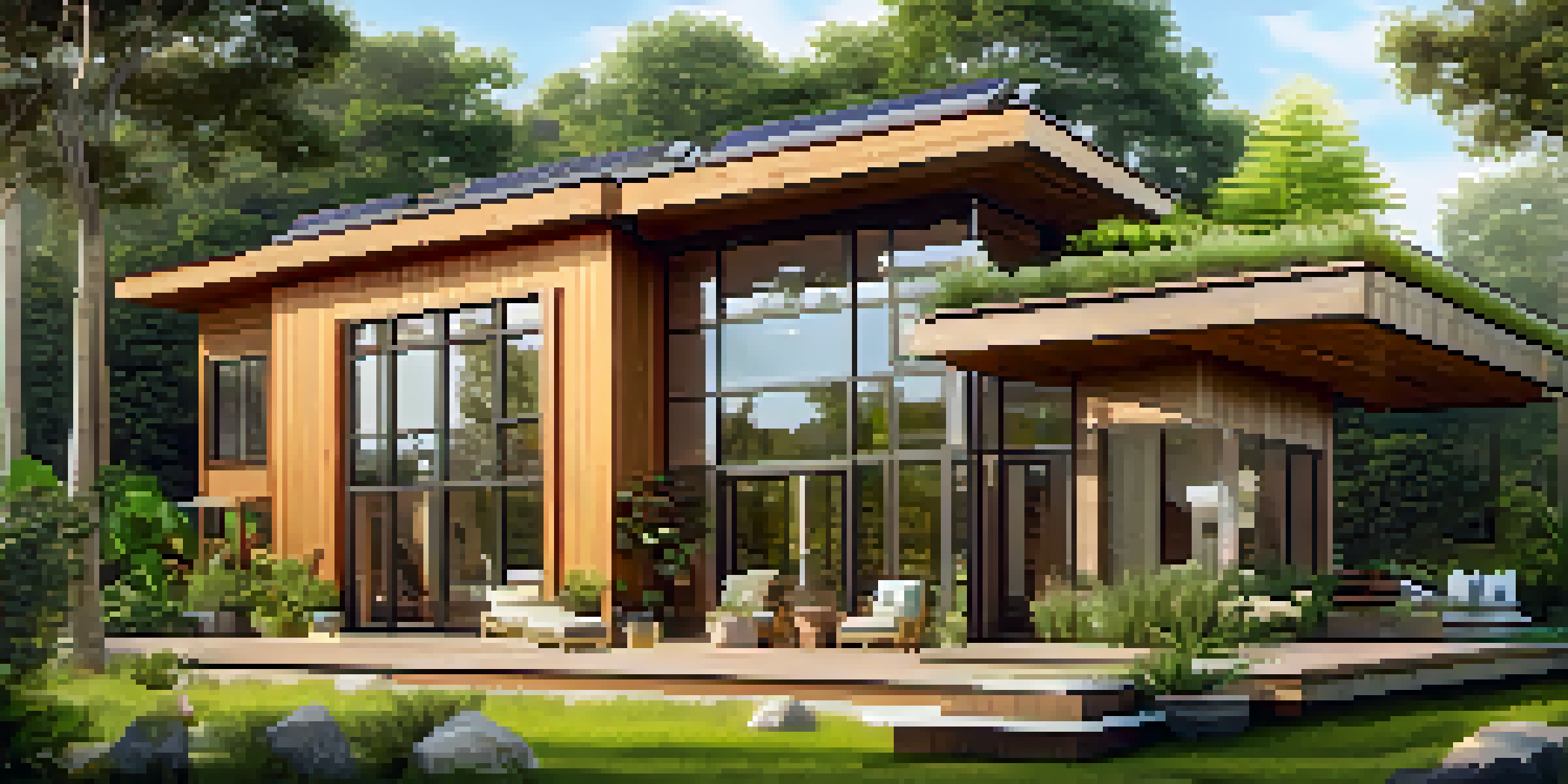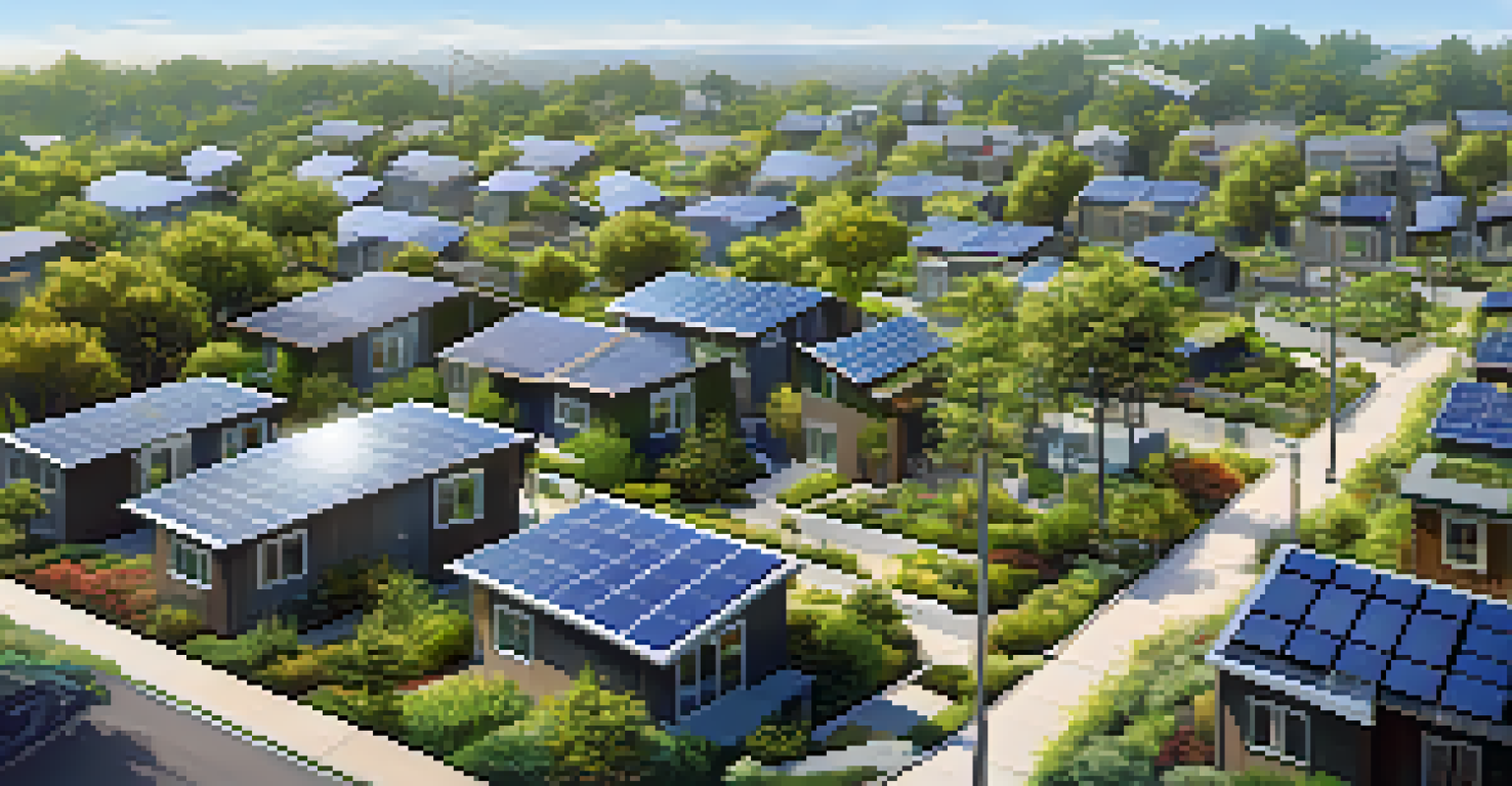The Role of Energy-Efficient Home Designs in Modern Architecture

Understanding Energy Efficiency in Home Design
Energy efficiency in home design refers to creating spaces that use less energy for heating, cooling, and lighting. This approach not only reduces energy bills but also minimizes environmental impact. Think of it like using a thermos for your coffee; it keeps your drink hot longer without wasting energy.
The greatest threat to our planet is the belief that someone else will save it.
Modern architecture incorporates energy-efficient designs by utilizing sustainable materials and innovative technologies. For example, homes can feature better insulation, smart thermostats, and energy-efficient windows that help regulate indoor temperatures. These elements work together to create a comfortable living environment while conserving energy.
Ultimately, energy-efficient home designs contribute to a healthier planet. By consuming less energy, we reduce our reliance on fossil fuels, leading to fewer greenhouse gas emissions. This shift towards efficiency is not just a trend; it's a necessary step for sustainable living.
Key Features of Energy-Efficient Home Designs
One of the main features of energy-efficient homes is proper insulation. Insulation acts as a barrier to heat loss in winter and heat gain in summer, keeping homes cozy year-round. Imagine wearing a warm sweater: it keeps you comfortable without needing the heater cranked up high.

Another important aspect is the use of energy-efficient appliances. These devices use advanced technology to consume less electricity and water, which significantly lowers utility bills. For instance, a modern dishwasher can save thousands of gallons of water over its lifetime compared to an older model.
Energy Efficiency Benefits Homeowners
Energy-efficient home designs reduce utility bills and environmental impact while enhancing comfort.
Natural lighting is also a crucial feature. By strategically placing windows and using skylights, homeowners can reduce the need for artificial lighting during the day. This not only cuts down on energy use but also enhances the overall ambiance of the home, making it feel more open and inviting.
The Role of Renewable Energy Sources
Incorporating renewable energy sources, such as solar panels, plays a vital role in energy-efficient home designs. These systems harness sunlight to generate electricity, significantly reducing reliance on traditional power sources. It’s like having a personal energy factory right on your roof!
Energy conservation is the foundation of energy independence.
Wind turbines and geothermal heating are other renewable options that can enhance a home's energy efficiency. By using these resources, homeowners can create a more self-sufficient living space, lowering both costs and environmental impact. Imagine generating your own energy; it’s empowering and sustainable.
As technology advances, the integration of renewable energy in home designs continues to improve. Innovations make it easier for homeowners to monitor and manage their energy use, further promoting efficiency. This harmony between architecture and nature is paving the way for a greener future.
Sustainable Materials in Energy-Efficient Homes
Sustainable materials are a cornerstone of energy-efficient home designs. These materials are sourced responsibly and often have a lower environmental impact compared to conventional options. For instance, bamboo is a rapidly renewable resource that’s becoming popular for flooring and cabinetry.
Recycled materials also play a significant role in sustainable architecture. Using reclaimed wood or recycled metal not only reduces waste but also brings unique character to a home. It’s like giving new life to something old, making it both beautiful and eco-friendly.
Renewable Energy Powers Sustainability
Incorporating renewable energy sources like solar panels helps homeowners lower costs and reliance on traditional energy.
By choosing sustainable materials, homeowners can create spaces that reflect their values while maintaining style. This commitment to sustainability can also increase property value, as more buyers are looking for eco-friendly features. It’s a win-win situation for both the planet and the homeowner.
The Impact of Smart Home Technologies
Smart home technologies have revolutionized energy efficiency in modern architecture. These systems allow homeowners to control lighting, heating, and even appliances remotely, optimizing energy use in real-time. Imagine being able to adjust your thermostat from your phone while you're at work; that’s the power of smart technology.
Energy monitoring systems provide valuable insights into energy consumption patterns. By understanding when and where energy is used, homeowners can make informed decisions to reduce waste. It’s like having a personal energy coach guiding you toward efficiency.
Moreover, integrating smart technologies can enhance comfort and convenience. Automated lighting systems can adjust based on natural light levels, while smart thermostats learn your schedule to minimize energy use. These innovations not only save energy but also enhance the overall living experience.
Regulations and Incentives for Energy-Efficient Designs
Governments and organizations are increasingly recognizing the importance of energy-efficient home designs. Many regions have implemented building codes that encourage or require sustainable practices. These regulations aim to create a standard for energy efficiency in construction, ensuring that new homes contribute positively to the environment.
In addition to regulations, various incentives exist to encourage homeowners to adopt energy-efficient practices. Tax credits, rebates, and grants can significantly offset the cost of upgrades like solar panels or energy-efficient appliances. It’s like getting paid to be responsible with your energy use!
Smart Technologies Enhance Efficiency
Smart home technologies optimize energy use and improve convenience, making homes more comfortable and eco-friendly.
These initiatives not only promote sustainable living but also help drive innovation within the industry. As more builders and homeowners embrace these practices, the market for energy-efficient homes continues to grow, making it a vital part of modern architecture.
The Future of Energy-Efficient Home Designs
The future of energy-efficient home designs looks bright, with ongoing advancements in technology and materials. As architects and builders become more skilled in sustainable practices, we can expect to see even more innovative solutions. Picture homes that not only produce their own energy but also purify the air and recycle water.
Consumer awareness is also increasing, with more people seeking out energy-efficient options when buying or building a home. This demand drives the market to evolve, pushing for better designs and technologies. It’s similar to how electric vehicles have become more popular; the desire for sustainability is changing the landscape of home architecture.

Ultimately, the integration of energy-efficient designs into modern architecture is not just a trend; it’s a necessary step towards a sustainable future. By prioritizing energy efficiency, we can create homes that are not only comfortable and stylish but also environmentally responsible.